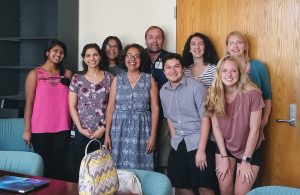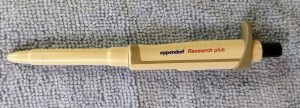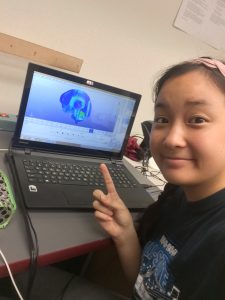When I found out that I had been placed in Dr. Sheila Patek’s lab for BSURF, I almost burst with excitement. As a scuba diver who has grown up swimming around the islands of the Philippines, I’ve fallen in love with marine life, and with animals in general! The Patek Lab is one of the few labs on Duke’s main campus that studies marine animals, studying things such as the acoustics and fast-movement systems of the amazing mantis shrimp, as well as other organisms like fungi and trap-jaw ants. Coming in this summer I already had a broad idea of what I might be doing for my research project: studying the spines* of mantis shrimp and other animals, and seeing how the structures of these spines affect their puncture mechanics. In other words, printing model spines out and poking ballistic gel.
One of the things I hope to do this summer is gain more technical knowledge on the procedures I use in my project. For example, my project involves a fair amount of 3D modeling and printing, neither of which I had ever done before. However, for the past week I’ve had the good fortune of being able to practice operating the Patek Lab’s Makerbot 3D Printer, and try my hand at a few different modeling programs. This meant that by Friday afternoon, I was grinning down stupidly at a 2-inch lionfish spine that I had isolated from a CT scan and printed out myself, and my initial doubts about my ability to handle my project had been sizably quelled. I’m hoping that I’ll continue to make progress in learning different scientific and technical techniques; and in the end, I hope to come out not only with a toolkit of skills that I can use in future projects, but also with more confidence in my ability to conduct research.
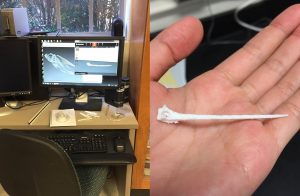
Left: my work at the lab’s computer. On the display you can see a lionfish skeleton and an isolated lionfish spine ready for printing. Right: The spine has been printed!
I also hope to gain a better idea about what life is like in the lab, both in terms of working with other lab members and in terms of workload. The discovery of new knowledge about the natural world is an inherent part of research, and this enticing prospect is what causes me to seriously consider research as a career path. However, I don’t believe that I can dive into research without at least making an effort to learn about how it may (or may not) change my work habits, work-life balance and other aspects of life. By interacting with/observing my fellow lab members and asking lots of questions, hopefully I can gain a more accurate picture of what it means to be a research scientist, and decide whether that is truly the life for me.
Overall, through BSURF I hope to learn more about methods for exploring science, learn more about a living a life dedicated to research, and in the process, learn more about myself and my capabilities as a scientist. And no matter what I discover or decide by the end, I hope that this summer will be a fun and eye-opening one!
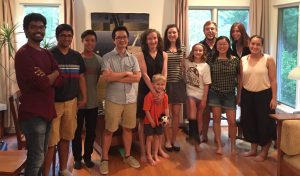
The Patek Lab members (+ the two Patek kids) over at Dr. Patek’s for dinner last Friday!
*The stabby bits, not the backbone 😀

